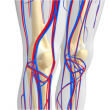The use of drub coated balloons (DCB) in the treatment of femoropopliteal artery disease has grown. Studies on first generation high dose DCB (HD-DCB) have shown benefits, which has led to their recommendation by current guidelines. However, there have been reports of secondary effects caused by paclitaxel and its excipients. Second generation low dose DCB...
The most read scientific articles in interventional cardiology in February on our website
Below, we share February’s most read scientific abstracts in interventional cardiology at solaci.org. Can Drug Coated Balloon Be a Valid Option for Small Vessels? One of the challenges of percutaneous coronary interventions (PCI) are <2.5 mm vessels, since complications and restenosis complications rate are higher than with >3.0 mm vessels. Is Using Drug-Eluting Balloons and...
Arterial Patency in Femoropopliteal Disease with Drug-Eluting Balloons
Follow-up of drug-coated balloon angioplasty in femoropopliteal disease in a real-world population. Using drug-releasing devices has decreased the rate of restenosis in obstructive femoropopliteal lesions compared with conventional balloons or conventional stents (bare-nitinol stent, BNS). Both in the placement of BNS and of drug-eluting stents (DES) there is a mechanical risk of stent fracture or...
Stent Revascularization in Femoropopliteal Disease: An Analysis of Clustered Randomized Trials
A study compared pooled data of claudication and critical ischemia patients treated with stenting vs. by-pass surgery in femoropopliteal disease. The main objective of revascularization in femoropopliteal disease is to improve the quality of life and functional capacity of claudication patients who did not respond to medical treatment, and to save the affected limb in...
Watch again the 7° ProEducar Educational Meeting on Extracardiac Interventions
Watch again the 7° ProEducar Educational Meeting on Extracardiac Interventions on our Youtube channel. In this video you will learn about: How to perform a carotid angioplasty and avoid complications? Educational Case. Step by Step – Dr. Estêvão Carvalho de Campos Martins (BRA). ntervention in lower limbs critical ischemia – Dr. Larry Díaz Sandoval (USA).
Complex PCI: Complex Characteristics Impact Results
Patients with a bigger number of complex anatomical characteristics that increase PCI complexity have worse results at one-year followup. These data come from a large multicenter study (e-Ultimaster) recently published in EuroIntervention. The more complex the characteristics, the greater the increase in events. It is important to see past the obvious anatomical challenges (bifurcations, calcification,...
Virtual ACC 2020 | VOYAGER PAD: Rivaroxaban Superior to Aspirin in Preventing Events
In patients with peripheral artery disease undergoing revascularization, the combination of rivaroxaban (Xarelto) and low doses of aspirin are superior to aspirin alone in the prevention of acute low limb ischemic events, amputation, cardiovascular events and strokes. The outcomes of VOYAGER PAD add to the COMPASS outcomes, showing the combination of therapies can benefit risk...
Drug-Coated Balloons in Infrapopliteal Disease: Much Ado About Nothing
The revascularization of tibial arteries in patients with critical lower limb ischemia using drug-coated balloons vs. conventional angioplasty resulted in comparable long-term outcomes in terms of both safety and efficacy. Paclitaxel exposure was not related to a higher risk of amputation or all-cause mortality at 5 years (which is the good news for much questioned drug-coated...
Angioplasty in Long Femoropopliteal Lesions Offers Reasonable Results
Courtesy of Dr. Carlos Fava. Around half the treated lesions in peripheral disease are femoropopliteal lesions. Long lesions are among the challenges faced: they are associated with higher mortality and morbidity, and revascularization in that setting always entails some degree of difficulty. Nowadays, with the development of nitinol stents and more operator experience, angioplasty is becoming...
Consensus on How to Conduct Follow-Up in Peripheral Vascular Disease
Peripheral vascular disease involves multiple areas and, therefore, can have very different presentations (from complete lack of symptoms to disabling symptoms). Depending on clinical presentation, general condition, anatomical localization, and lesion extension, revascularization can be indicated alongside optimal medical treatment. In 2017, guidelines with indications for revascularization were published; however, maintaining long-term patency can be...








